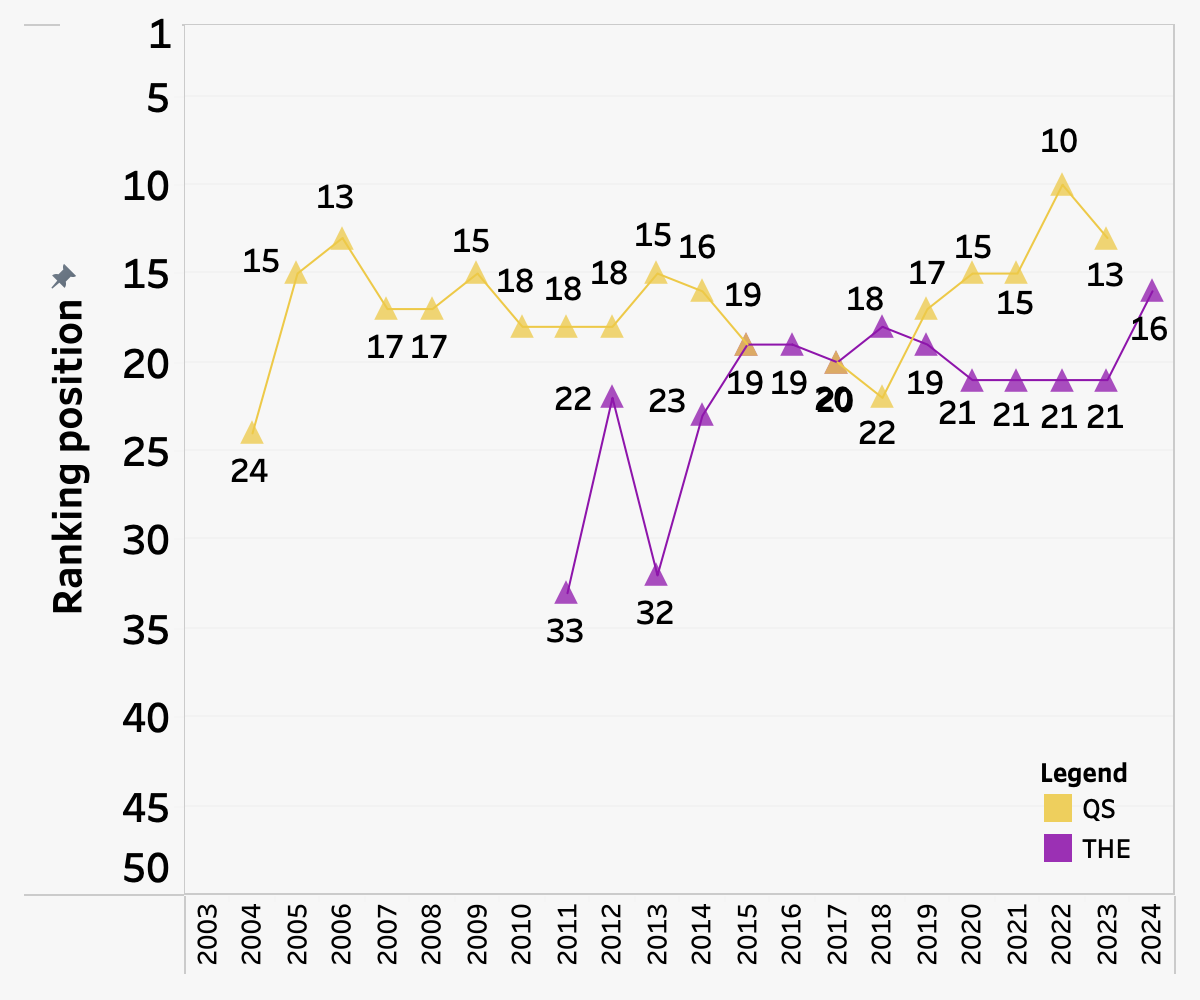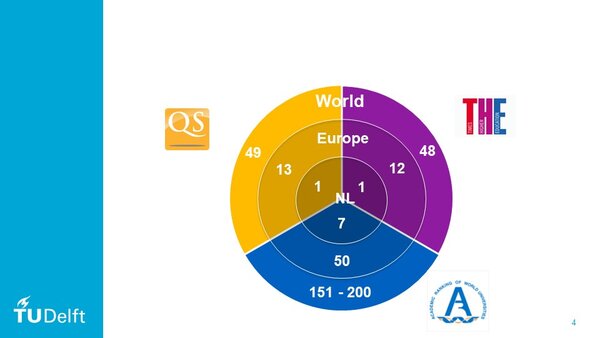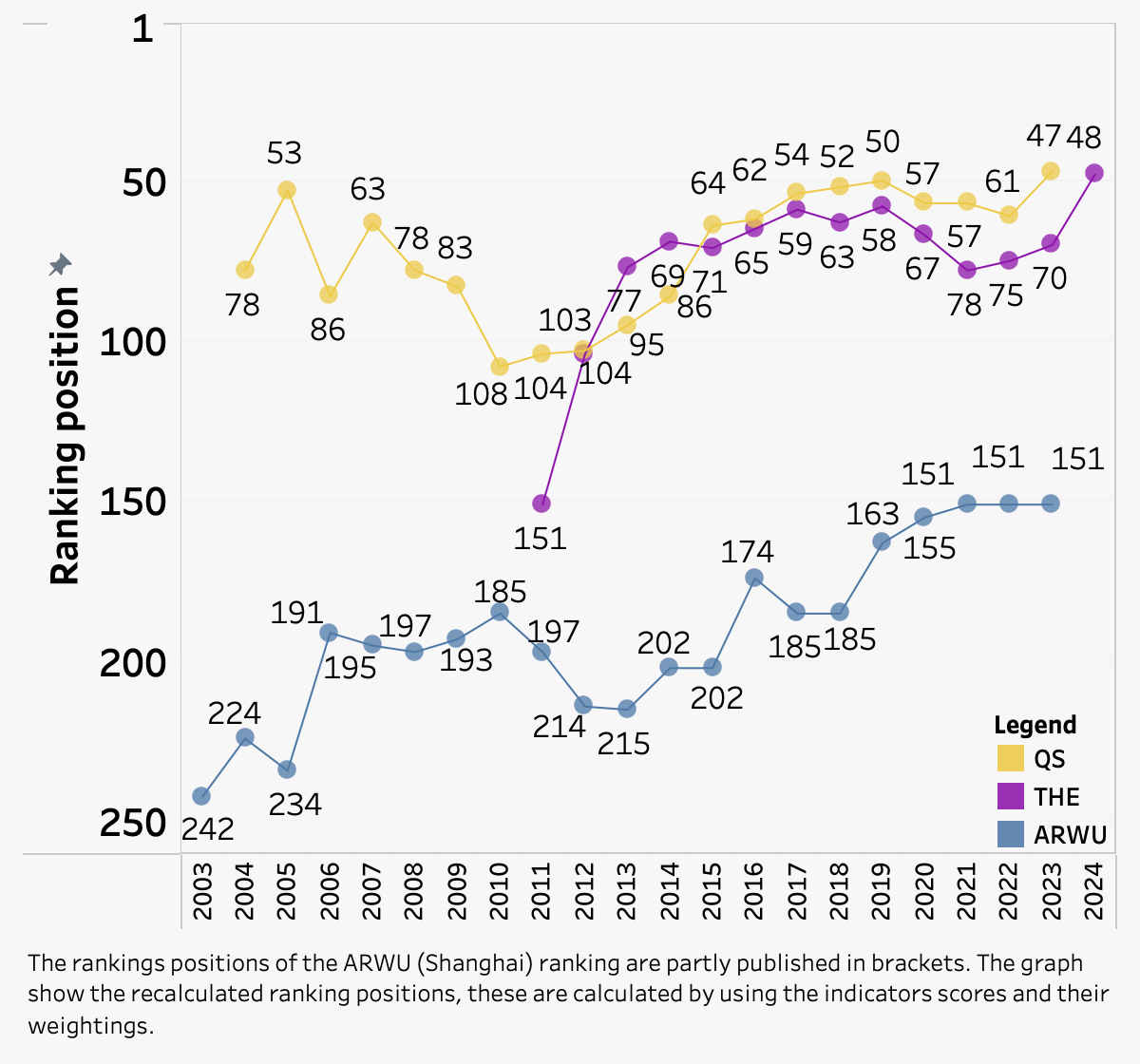TU Delft in International Rankings
Many organisations compile rankings and a university’s position can vary considerably from one ranking to another. How exactly do these rankings work and how does TU Delft fare in them?
The three most important rankings
TU Delft is particularly interested in three international rankings and closely follows their developments. These are the Quacquarelli Symonds (QS) ranking, the Times Higher Education (THE) ranking and the Shanghai Ranking (ARWU). These are the most well-known international rankings. They all have a proven track record and are fairly constant in terms of the methodology used and the frequency of publication. They are compiled in different ways, so we can assess our position in the world from different perspectives. All three rankings publish a World University Ranking (WUR) and Subject Rankings. Some also publish Themed Rankings, such as Employability, Reputation, Most International or Most Innovative University. For TU Delft, the WUR rankings and the Engineering & Technology rankings are particularly relevant, the later due to their focus. The Subject Rankings are of particular interest to the individual faculties and departments.
Subject rankings
There are many subject rankings out there; the QS and the ARWU both publish about 50 and the THE has about 10 – and many more are being added to the list regularly. The most important rankings for TU Delft are the Engineering and Technology rankings, in which the university consistently ranks in and around the top 20. If we look at specific subjects, TU Delft holds a good number of international top spots. TU Delft tops the lists for Architecture, Civil & Structural Engineering, Mechanical, Aeronautical & Manufacturing Engineering, Water Resources, Transportational Sciences, Marine/Ocean Engineering and Chemical engineering.
TU Delft’s position in World University Rankings
Of these three rankings TU Delft scores particularly well in the QS and the THE, featuring in the international top 50 and 70 respectively. In Europe, TU Delft is in the top 20 and in the Netherlands in the top 3.TU Delft’s position in the Shanghai Ranking is slightly lower, since this ranking focuses on different aspects; it is complied using different indicators and a different weightingmethod. Indicators that depend on a small number of individuals (Nobel laureates and prize winners, for example) determine half of the score for the ARWU ranking, while QS and THE do not take such indicators into account at all. TU Delft scores lower on these individual-dependent indicators. When using and analysing rankings, it is of course interesting to see the university’s current position but the long-term trend might actually be even more important. All three rankings have shown a relatively stable upward trend in recent years, with a slight fluctuation from time to time, which suggests that TU Delft’s international position is getting stronger and stronger.
Use of rankings
Although it is worthwhile considering the nuances when examining these rankings, they can be a valuable tool for the university: they can be used to benchmark universities, to identify and follow international trends and to attract (international) students and staff. For students (and their parents), especially those who want to study abroad, rankings are an important source of information. After all, they are an excellent tool for comparing a large number of universities. Employers seem to be attaching greater importance to the ranking of an applicant’s university and it is easier for a top-ranking university to enter into new collaborations and partnerships.
The limitations
Understanding rankings and following trends is important. At the same time, we recognise the shortcomings of rankings and the need to be aware of their limitations in order to be able to interpret them correctly, so that we do not draw the wrong conclusions. Mostly commercial ranking organisations use a simplified and limited methodology to make their assessments. It starts by deciding on the theme or focus of the ranking, and then continues with the selection of the indicators and the weighting method. In most cases, quantitative indicators are supposed to give an indication of the quality. The question is, however, whether quality can be captured in a quantitative indicator. For example, the “faculty/staff” ratio (ratio of students to academic staff) is supposed to indicate the quality of education, and the number of citations the quality of research. All universities are assessed using the same indicators, despite the fact that they may have different visions, missions and priorities. Furthermore, the position of a university or shifts in the ranking do not always tell the whole story about the actual achievements of universities. A university may perform better for one indicator but will still drop places if other universities have done even better. Some rankings ask universities to provide data themselves, and although there are guidelines for this, differences in the interpretation and accuracy of self-reported figures can occur.
Read also the “Ten principles for the responsible use of university rankings”, complied by Ludo Waltman, Paul Wouters and Nees Jan van Eck from the CWTS (Centre for Science and Technology Studies) on the responsible use of rankings.
Contact
Diverse rankings
There is a wide range of international rankings published every year. In addition to the QS, the THE and the Shanghai rankings, which are the most relevant to TU Delft, the university also keeps an eye on the following rankings.
Click here for an explanation of these rankings.
| Ranking Organization | Edition | Focus | |||
|---|---|---|---|---|---|
| Times Higher Education | 2023 | Impact Rankings - Overall | 101-200 | 36-86 | 1-3 |
| Times Higher Education | 2023 | Impact: Industry, innovation, and infrastructure | 5 | 5 | 2 |
| Times Higher Education | 2023 | Impact: Climate Action | 15 | 5 | 1 |
| Times Higher Education | 2023 | Impact: Affordable & Clean Energy | 79 | 19 | 1 |
| Times Higher Education | 2023 | Most international universities in the world | 15 | 8 | 1 |
| Times Higher Education | 2022 | World reputation rankings | 43 | 10 | 1 |
| Times Higher Education | 2022 | Global University Employability Ranking | 87 | 36 | 2 |
| Quacquarelli Symonds (QS) | 2022 | Graduate Employability Ranking | 39 | 7 | 1 |
| MOOCLab | 2021 | Rankings based on MOOC provision | 17 | 4 | 1 |




